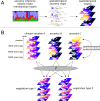The spatiotemporal spread of human migrations during the European Holocene
- PMID: 32238559
- PMCID: PMC7183159
- DOI: 10.1073/pnas.1920051117
The spatiotemporal spread of human migrations during the European Holocene
Abstract
The European continent was subject to two major migrations of peoples during the Holocene: the northwestward movement of Anatolian farmer populations during the Neolithic and the westward movement of Yamnaya steppe peoples during the Bronze Age. These movements changed the genetic composition of the continent's inhabitants. The Holocene was also characterized by major changes in vegetation composition, which altered the environment occupied by the original hunter-gatherer populations. We aim to test to what extent vegetation change through time is associated with changes in population composition as a consequence of these migrations, or with changes in climate. Using ancient DNA in combination with geostatistical techniques, we produce detailed maps of ancient population movements, which allow us to visualize how these migrations unfolded through time and space. We find that the spread of Neolithic farmer ancestry had a two-pronged wavefront, in agreement with similar findings on the cultural spread of farming from radiocarbon-dated archaeological sites. This movement, however, did not have a strong association with changes in the vegetational landscape. In contrast, the Yamnaya migration speed was at least twice as fast and coincided with a reduction in the amount of broad-leaf forest and an increase in the amount of pasture and natural grasslands in the continent. We demonstrate the utility of integrating ancient genomes with archaeometric datasets in a spatiotemporal statistical framework, which we foresee will enable future studies of ancient populations' movements, and their putative effects on local fauna and flora.
Keywords: Bronze Age; Neolithic; ancient DNA; land cover; migrations.
Copyright © 2020 the Author(s). Published by PNAS.
Conflict of interest statement
The authors declare no competing interest.
Figures








References
-
- Ammerman A. J., Cavalli-Sforza L. L., Measuring the rate of spread of early farming in Europe. Man 6, 674–688 (1971).
-
- Silva F., Steele J., New methods for reconstructing geographical effects on dispersal rates and routes from large-scale radiocarbon databases. J. Archaeol. Sci. 52, 609–620 (2014).
Publication types
MeSH terms
Substances
LinkOut - more resources
Full Text Sources

